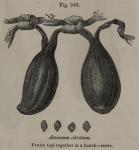84. Amomum citratum.
 Cardamomum majus.—In Dr. Burgess's collection at the College of Physicians is a capsule (in a bad state of preservation) marked "Cardamomum majus." It has a fibrous tuft at one extremity, and is much split at the other. The seeds are angular, oblong, larger than those of Malabar cardamoms, shining brownish-yellow, and have a large concave depression (hilum) at one extremity. They have a warm aromatic flavour, somewhat analogous to that of the oil of lemon-grass. When crushed, they evolve the odour of this oil. Hence I have given them the specific name "citratum," as by this character they are readily distinguished from all other seeds of this order with which I am acquainted.
Cardamomum majus.—In Dr. Burgess's collection at the College of Physicians is a capsule (in a bad state of preservation) marked "Cardamomum majus." It has a fibrous tuft at one extremity, and is much split at the other. The seeds are angular, oblong, larger than those of Malabar cardamoms, shining brownish-yellow, and have a large concave depression (hilum) at one extremity. They have a warm aromatic flavour, somewhat analogous to that of the oil of lemon-grass. When crushed, they evolve the odour of this oil. Hence I have given them the specific name "citratum," as by this character they are readily distinguished from all other seeds of this order with which I am acquainted.
I have found the same fruits in the Sloanian collection of the British Museum. They are tied together in bunches. One sample is unnamed; another is marked in the catalogue "12057. Grana Paradisi."
I have met with the same fruits in a collection at Apothecaries' Hall; and I am indebted to Mr. Warrington for the specimen from which Fig. 248 was taken. The capsules are tied together in bunches, as shown in the accompanying figure.

